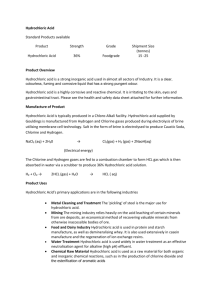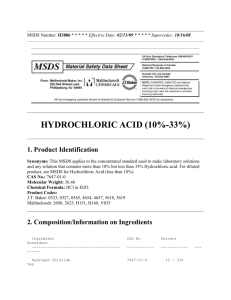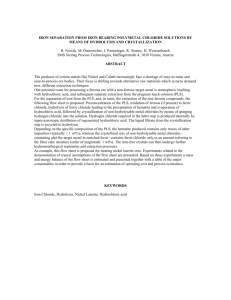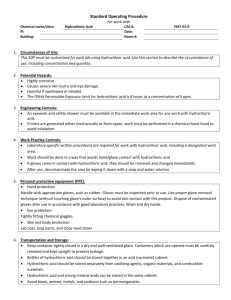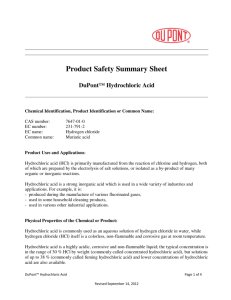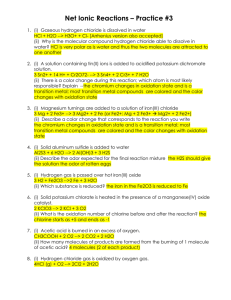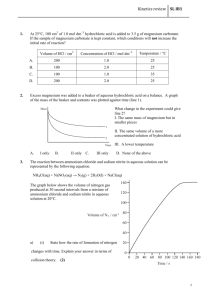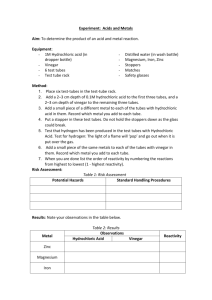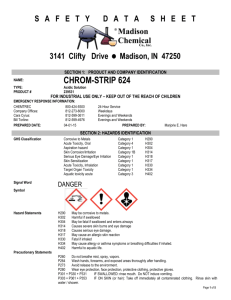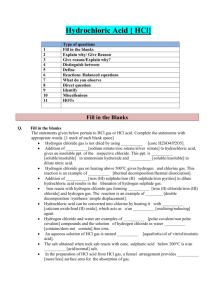HCl - Euro Chlor
advertisement
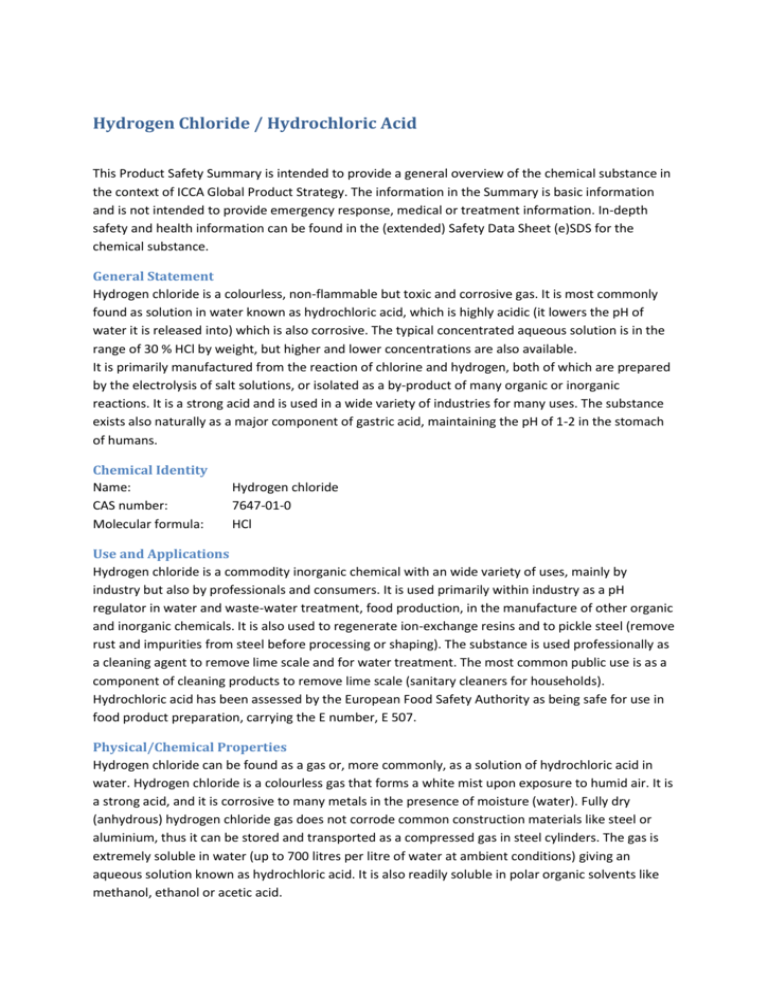
Hydrogen Chloride / Hydrochloric Acid This Product Safety Summary is intended to provide a general overview of the chemical substance in the context of ICCA Global Product Strategy. The information in the Summary is basic information and is not intended to provide emergency response, medical or treatment information. In-depth safety and health information can be found in the (extended) Safety Data Sheet (e)SDS for the chemical substance. General Statement Hydrogen chloride is a colourless, non-flammable but toxic and corrosive gas. It is most commonly found as solution in water known as hydrochloric acid, which is highly acidic (it lowers the pH of water it is released into) which is also corrosive. The typical concentrated aqueous solution is in the range of 30 % HCl by weight, but higher and lower concentrations are also available. It is primarily manufactured from the reaction of chlorine and hydrogen, both of which are prepared by the electrolysis of salt solutions, or isolated as a by-product of many organic or inorganic reactions. It is a strong acid and is used in a wide variety of industries for many uses. The substance exists also naturally as a major component of gastric acid, maintaining the pH of 1-2 in the stomach of humans. Chemical Identity Name: CAS number: Molecular formula: Hydrogen chloride 7647-01-0 HCl Use and Applications Hydrogen chloride is a commodity inorganic chemical with an wide variety of uses, mainly by industry but also by professionals and consumers. It is used primarily within industry as a pH regulator in water and waste-water treatment, food production, in the manufacture of other organic and inorganic chemicals. It is also used to regenerate ion-exchange resins and to pickle steel (remove rust and impurities from steel before processing or shaping). The substance is used professionally as a cleaning agent to remove lime scale and for water treatment. The most common public use is as a component of cleaning products to remove lime scale (sanitary cleaners for households). Hydrochloric acid has been assessed by the European Food Safety Authority as being safe for use in food product preparation, carrying the E number, E 507. Physical/Chemical Properties Hydrogen chloride can be found as a gas or, more commonly, as a solution of hydrochloric acid in water. Hydrogen chloride is a colourless gas that forms a white mist upon exposure to humid air. It is a strong acid, and it is corrosive to many metals in the presence of moisture (water). Fully dry (anhydrous) hydrogen chloride gas does not corrode common construction materials like steel or aluminium, thus it can be stored and transported as a compressed gas in steel cylinders. The gas is extremely soluble in water (up to 700 litres per litre of water at ambient conditions) giving an aqueous solution known as hydrochloric acid. It is also readily soluble in polar organic solvents like methanol, ethanol or acetic acid. Hydrochloric acid is a corrosive, non-flammable liquid; the typical concentration is in the range of 30 % HCl by weight (so-called concentrated hydrochloric acid), but solutions of up to 38 % (so-called fuming hydrochloric acid) are used in industry, as well as lower concentrations. If concentrated hydrochloric acid is heated to boiling it will release HCl gas and form an azeotrope which boils at 110 °C at 1013 mbar and contains 20.2 % HCl. The corrosivity against common metals, lime stone etc. depends strongly on the concentration of the hydrochloric acid. Consumer products typically contain only small amounts of HCl (1-2 %), which are further diluted for use in households. Property Physical state Colour Odour Density at 20 °C Melting temperature Boiling temperature Molecular weight HCl gas gaseous Colourless Sharp acidic odour 1.64 g/L (gas is heavier than air) -112 °C -85 °C 36.5 g/mol Hydrochloric acid (30 % HCl) liquid Colourless acidic odour 1.149 ca. -50 °C ca. 110 °C n.a. Human Health Safety Assessment The substance, both as a gas and as an aqueous solution, is a strong acid and is therefore strongly corrosive to human tissue. Exposure to the substance will cause strong burns to unprotected eyes and skin. Inhalation of the gas and mist (fumes) can cause irritation and, in serious cases, can lead to pulmonary oedema and death. Hydrochloric acid exists naturally as a major component of gastric acid, maintaining a pH of 1-2 in the stomach (the stomach has uniquely evolved to deal with the high acidity). The uses identified for the substance have been assessed as safe under several regulatory programs, when it is used appropriately and with relevant safety measures. Professional and industrial workers need to ensure that they follow the advice found in the extended safety data sheet (eSDS). For household use, all instructions found on the packaging should be followed by the consumer. Environmental Safety Assessment Hydrochloric acid lowers the pH of any water that it is released into. Small amounts are diluted and neutralised by reaction with the basic substances present in natural waters and soil. If a large amount is released or if other acids are present, the pH could be lowered until it is harmful for aquatic animals and plants (at pH 3 to 5). As this is a generic pH effect and is not due to the specific substance, hydrogen chloride is not classified as toxic to the aquatic environment. Additionally, the substance is not bioaccumulative, is rapidly removed (neutralised to water and chloride ions, which are both harmless) and will not persist in the environment. Exposure Human Health The different uses of the substance have been assessed as safe under several regulatory programmes, provided the necessary control measures are put in place. Consumers can come into contact with the substance through its use as a component of some household cleaners. This use has been assessed as safe, provided that the product is used as directed on the label. The substance has been assessed as safe for professional and industrial use, when the provisions laid down in the eSDS are followed carefully. Uses advised against are those that may lead to aerosol formation (mists), which could be harmful for the eyes, skin and respiratory system. Environment Hydrogen chloride release into the environment does not normally occur, as the gas is used only by industry within closed systems under controlled conditions. Industrial waste-water containing hydrochloric acid is neutralised by the addition of a basic substance to give a neutral solution, which can be safely disposed of. Small-scale release into drains from household cleaning products poses no risk to the environment due to the large dilution of the acid and neutralisation by the buffering capacity of the system or natural waters. Regulatory Information The substance was reviewed in 2002 under the OECD HPV program (assessment of chemicals produced in high volumes). In 2010 it was reviewed and registered under the European REACH Regulation (EC) No. 1907/2006 and the substance was found to be safe for the uses identified. Currently it is under review for the European Biocidal Products Directive 98/8/EC. Classification and Labelling The substance is subject to harmonised classification under the EU Classification, Labelling and Packaging Regulation (EC) No. 1272/2008, (CLP regulation). Industry has adopted a more stringent self-classification, as follows: a) for HCl Gas Hazard Class Hazard No. Pressurised gas * H280 Acute toxicity 3 H331 Skin Corrosion 1A H314 Hazard Statement Pictogram Contains gas under pressure; may explode if heated Toxic if inhaled Causes severe skin burns and eye damage (*) This hazard classification is only valid in case the substance is marketed and used under pressure above 2 bars. b) for Hydrochloric Acid The classification for hydrochloric acid depends on specific concentration limits, as at low concentrations (higher dilutions) the acid is less hazardous. Hazard Hazard Statement No. Hydrochloric Acid with ≥25 % HCl Hazard Class Metal Corrosion 1 H290 May be corrosive to metals Skin Corrosion 1B H314 Causes severe skin burns and eye damage Pictogram Specific target organ toxicity H335 May cause respiratory irritation single exposure 3A Hydrochloric Acid with ≥10-25 % HCl Metal Corrosion 1 H290 May be corrosive to metals Eye Irritation 2 H319 Causes serious eye irritation Skin Irritation 2 H315 Causes skin irritation Specific target organ toxicity H335 May cause respiratory irritation single exposure 3A Hydrochloric Acid with ≥0.1-10 % HCl Metal Corrosion 1 H290 May be corrosive to metals Please note that packaging labels may differ from the classification above. For complete details on the classification and labelling of hydrogen chloride or hydrochloric acid (comprising also the full set of precautionary statements), consult the (e)SDS. Conclusion Hydrogen chloride is a well-understood substance that is useful for numerous practical applications, stretching from industry to consumer products. Use of this hazardous substance has been shown to be safe when care is taken during its use and instructions provided are followed. Contact Information within Company For further information on this substance or product safety summaries in general, please contact: Xxxxx Xxxxx at xxxxxx@xxxxx.com or visit our website at www.xxxx.com. Euro Chlor (www.eurochlor.org), the European chlor-alkali manufacturers association is a useful repository of information regarding chlorine and can be contacted at eurochlor@cefic.be. Additional information on the ICCA global product strategy can be found here: http://www.iccachem.org/en/Home/ICCA-initiatives/global-product-strategy/ Glossary Acute toxicity Biodegradable Bioaccumulation Chronic toxicity Date of Issue xx/xx/xxxx Revised xx/xx/xxxx harmful effects after a single exposure breakdown of materials by a physiological environment accumulation of substances in the environment harmful effects after repeated exposures
